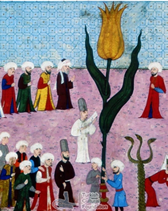Within 16th century Ottoman culture, gardens were both spiritual and intellectual spaces. Gardens were places for the religious scholars (meclis-i ulema) to study and contemplate the marvels of Allah the Creator. Flowers evoked Qur’anic descriptions of Paradise and the garden of Eden.[1] Also, gardens were spaces for cultured companionship (sohbet) between courtiers and intellectuals.[2]
Outdoor social gatherings were fundamental to Ottoman society as a whole, and a central activity in the culture of the educated elite.[3] 16th-century Ottoman miniatures exhibit gardens as ideal spaces for all sorts of social gatherings – dinners, holiday festivities, circumcision feasts and weddings.
Whoever wants a party in the rose garden
let him have private sohbet
With a beloved whose hair is a hyacinth
whose face is a rose, lips a bud
Revani (d. 1524)
The Tulip (lâle)
 On The Courtauld dish, the pair of tulips is the obvious focal point. This resonates with the mystic (Sufi) perception of the ‘centred’ divine manifestation. Within Ottoman culture, the tulip had a special symbolic importance and was regarded as the holiest of all the flowers.
On The Courtauld dish, the pair of tulips is the obvious focal point. This resonates with the mystic (Sufi) perception of the ‘centred’ divine manifestation. Within Ottoman culture, the tulip had a special symbolic importance and was regarded as the holiest of all the flowers.
The Ottomans embroidered tulips onto underclothes, as amulets, to guard themselves against danger, harm or misfortune. It was the flower of God because the letters used in the Ottoman word for tulip (لال) are the letters used to write the name of God (الله). The tulip also represented the virtue of modesty before God because, when in full bloom, it bows its head.[4]
For the romantic poets, the tulip represented the cheek of the beloved
Those tulip-cheeked girls- what they dared do
in the garden!
Beside them, the cypress could not sway,
nor the rosebuds open
Nejati (d.1509)
Carnations (karanfil)
Because of its extended blooming period, the carnation (Karanfil) was thought to be a symbol of the power and renewal of life. On The Courtauld dish, the carnation, the symbol of life, twines around and embraces the tulip, the symbol of the ‘divine’ or the source of life. Based on the many Ottoman Sultans and admirals portrayed while holding a carnation, it is tempting to speculate that the carnations retained their political meaning.
Hyacinth (sümbül)
 The hyacinth in the 16th-century Ottoman love lyric, or gazel, has been interpreted as a metaphor for the beloved’s curls.[5]
The hyacinth in the 16th-century Ottoman love lyric, or gazel, has been interpreted as a metaphor for the beloved’s curls.[5]
What do you say about that Hyacinth curl,
along with those cheeks of rose?
Revani (d. 1524)
Hazrat Mevlana Rumi, the founder of the Ottoman Mevlevi Sufi order, used the hyacinth to praise Prophet Muhammad (PBUH) in one of his lyrics, the Na’t. The ‘exalted’ hyacinth acquired a special status among the flowers representing the Prophet, and thus the poet’s or artist’s sincerity in loving the Prophet:
Oh the Beloved of Allah! You are the Prophet of the Mighty Creator
You are pure and peerless amongst the servants of Allah.
The cypress of the Prophets’ Garden, You are the spring of the world of insight
You are the rose of the Sharia Garden, the Exalted Hyacinth!
Hazrat Mevlana Rumi (c. 1258)
Plum Blossom (karayemiş)
 The flowering plum blossoms (or prunus), the outermost floral spray on the displayed dish, was a common motif in the Kara Memi style.
The flowering plum blossoms (or prunus), the outermost floral spray on the displayed dish, was a common motif in the Kara Memi style.
The prunus was used on the tiles of entrances to the tombs of Sultan Suleyman’s wife Hasseki Hürram and the grand vizier Rüstem Pașa. The prunus is also used to decorate the mihrabs and minbars of several mosques such as those of Hasseki Hürram, Sultan Selim and Sokollu Mehmet Pașa. Its conventional decorative usage suggests it was intended to convey the lush green bounty of Paradise.[6] On the dish, the prunus or plum blossom might then complement the mystical Sufi theme, in that, as the symbol of bounty, it encompasses all the other flowers within its perimeter.
References
[1] Mikhail B Piotrovsky and (ed.) John Vrieze (2000). Art of Islam: Heavenly Art, Earthly Beauty. (Amsterdam: Lund Humphries Publishers).
[2] Walter G. Andrews and Mehmet Kalpakli (2005). The Age of the Beloved: Love and the beloved in early modern Ottoman and European culture and society (USA: Duke University Press Books). p.106.[3] Gábor Ágoston, and Bruce Alan Masters. Encyclopedia of the Ottoman Empire. p.272 .
[4] Walter G. Andrews, Najaat Black and Mehmet Kalpakli (2006). Ottoman Lyric Poetry: An Anthology (University of Washington Press). p. 107.
[5] Nurhan Atasoy, and Julian Raby (1989). Iznik: The Pottery of Ottoman Turkey (London: Alexandria Press). p.223.
[6] Walter G. Andrews (2008). “Gardens—Real and Imagined—in the Social Ecology of Early Modern Ottoman Culture,” in Garden Imagination: Historical Forms and Cultural Roles, Michel Conan, ed., Dumbarton Oaks Colloquium Series in the History of Landscape Architecture, 2008.
Back to Iznik Dish





